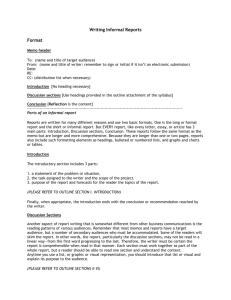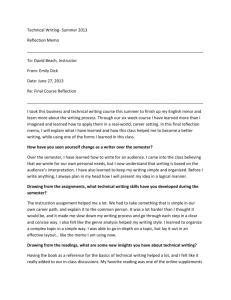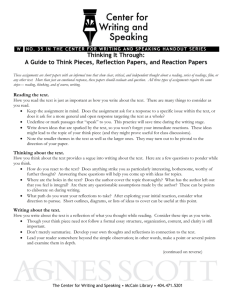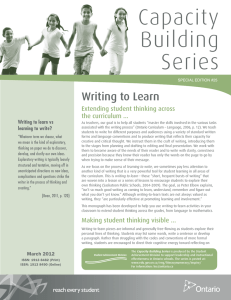Handout 1 - Legal Writing Institute
advertisement
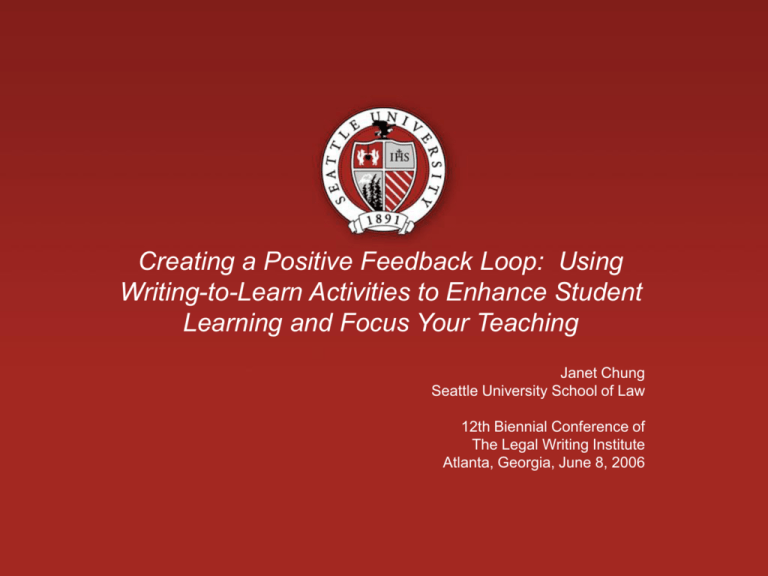
Creating a Positive Feedback Loop: Using Writing-to-Learn Activities to Enhance Student Learning and Focus Your Teaching Janet Chung Seattle University School of Law 12th Biennial Conference of The Legal Writing Institute Atlanta, Georgia, June 8, 2006 Presentation Objectives: • Provide an introduction to the learning theories supporting the use of writing-to-learn activities, including key concepts and terminology • Present a sampling of different writing-to-learn activities that can be incorporated into the curriculum • Provide an opportunity to discuss how to address logistical challenges, such as deciding optimal timing for such activities in the curriculum and how to use related student work product to improve teaching without increasing professor workload Free Write Exercise • Please see page 3 of your handout. What Is Writing to Learn? • “Writing is how we think our way into a subject and make it our own. Writing enables us to find out what we know – and what we don’t know – about whatever we’re trying to learn.” (Zinsser) • “[W]riting is viewed as a means, as a tool, for learning more information, or for coming to a more confident understanding of ideas that are still in development.” (J. Marshall, cited in Lysaght & Lockwood) What is Metacognition? • Thinking about thinking. Writing as a Product: Think, then write • A.k.a. positivist, formalist, instrumentalist • Teacher talks about rules of writing, organization, and editing • Writer uses written word to record or transcribe thoughts onto paper – i.e. the hand takes dictation from the brain (Beazley) • Teacher grades the final product Positivist Model of the Writing Process 1. Choose a topic. 2. Narrow it. 3. Write a thesis. 4. Make an outline. 5. Write a draft. 6. Revise. 7. Edit. (Bean) Writing as a Process: Thinking through writing • Critical, epistemic, constructivist • Writer’s dialogue about subject (either with self or with others/teacher) produces fuller, deeper, complex knowledge • Writers work recursively on research, writing, and revision • Written product moves from writer-based (used to help writer “make meaning”) to reader-based (used to communicate) Reader-based aspect of legal writing • Social perspective, or social constructionist: Writer must understand the social context, or discourse community, within which writing takes place • Thus, legal writers follow rules and conventions (format, grammar and citation, etc.) • to gain credibility with readers (e.g., judges and clerks) and • because the legal reader expects this form of information, analysis, and presentation The Writing Process • • • • • Identification of a problem Exploration/research First draft Reformulation or re-vision Editing (Bean) How Students Learn: Schema Theory • Focus is on how mind processes information • Mind receives information and tries to place it within individual’s existing knowledge structure • Internal mental structures organize information into schema, or meaningful organizations of concepts Schema Theory: Building New Structures • Working memory is limited • Images • Serial position (first, last) • Long-term memory is where substantive doctrines and concepts are stored • Learning occurs when cognitive structures are modified or created • Experts possess cognitive structures organized for a subject and can easily access schemas to assist in problem-solving within the conventions of the applicable discourse Metacognition Defined • Thinking about thinking – continuous recognition of and reflection on how the individual learns • If students think about how they learn, they can better employ learning methods to develop schema “It’s not teaching that causes learning. Attempts by the learner to perform cause learning, dependent upon the quality of feedback and opportunities to use it.” (G. Wiggins, cited by T. Huston & P. Lustbader, 2005 Seattle U. New Faculty Institute presentation) Self-Regulated Learning Cycle (recursive) Forethought (goal-setting, planning, etc.) Performance (implementation, self-monitoring, etc.) Reflection (self-evaluation, adaptation, etc.) Teacher’s Role in Helping Novices Become Experts • Promote self-regulated (autonomous) learning by helping students assume responsibility for their own learning processes • Engage in own self-regulated learning process vis-à-vis teaching Note: Writing is not knowledge-transforming when … • The writer is simply presenting information that s/he knows well and • The writing task interferes with the type of learning being sought • Example: student’s goal is simply to memorize a rule – an exercise that requires more than simply copying the rule may result in worse, rather than better, recall of that rule • Instead of spending time rehearsing the information to be memorized, student spends time thinking about the composing process itself (e.g. sentence structure, punctuation, spelling) (Oates) Writing-to-Learn Activities for the Legal Writing Classroom • Research/planning • Drafting/revising • Reflection • Note: professor should engage in research/planning in designing the exercise Research/planning • Reading journals – “think alouds” as they read cases • Annotated research logs (why did they choose a source, their assessment, where does the source point them to next, etc.) Sample Case Chart CASE NAME ELEMENT or FACTOR RULES FACTS, HOLDING, REASONING FACTS TO COMPARE IN OUR CASE Research/planning: Sample reflective questions 1. Did you face any obstacles in getting started with your research? If you did, what did you do to overcome this obstacle? 2. Did you try any new strategies in recording your research efficiently? For example, did you make handwritten annotations on printouts; did you copy and paste material from online research results; or did you create charts to organize information from cases? If you did not use new strategies, what strategies did you use that you used before in researching prior memos? Please describe. 3. If you used a new strategy, how would you evaluate the effectiveness of the new strategy or strategies? Did it help make your research and preliminary analysis more efficient? Or, if you did not use any new strategies, are there strategies you have tried before but decided not to use this time? 4. Based on your research so far, have you identified more specific questions in addition to your preliminary research question – either legal questions for further research, or questions about the facts that require further investigation? If yes, what are those questions? Drafting/revising • Electronic discussion board (e.g., TWEN) • students can post or respond to questions • students post results of group work (outlines, drafts) • Annotated drafts: use Microsoft Word comment function to record reflections and questions Drafting/revising • Private memos – along with draft, students record thoughts and anxieties that occurred while writing (Beazley) • Self-graded draft – students highlight or annotate to identify types of information that reader expects to find – rule, rule explanation/proof, application of rules to facts Reflection • Free write at end of project on questions posed by professor • Ask students to reflect on various stages of process • Letters to “future self” (e.g., addressing “what I wish I’d known”) to be returned to student at some later point • Guided journals • Annotated portfolios Reflection: Sample questions 1. What part of the memo-writing process was most challenging for you with Memo 4? (Examples are starting the research, finding cases, analyzing cases, organizing your research results, organizing the written draft, citechecking – or any other stage of the process that you can identify.) 2. What did you do to meet this challenge and overcome any obstacles at this point in the research/writing process? 3. In terms of the organization of this memo, what were some similarities with other memos you have done for this class? What were some differences? Sample response to Q about reading strategies for memo v. class This is very different than analyzing cases in my other law classes because all I’m doing there is basically trying to answer, “what is the point, or rule, of this case?” This is consistent with the first step in legal writing, but I have to go the next step in this class and determine how I would apply this rule to my fact pattern. Come to think of it, I do have to do this when I take a final exam in my other classes, in that I have to apply the rules to the fact pattern in the test question. OK, maybe the strategies are similar; I just didn’t realize it until just now. Designing a Writing-to-Learn Activity for Your Class Please turn to page 5 of the handout. Working in groups of 3-4, • Select an activity • Identify challenges to implementing this activity in your class • Identify solutions to each challenge What to do with the feedback? Note: The assumption is that for the student, there is some learning just in doing the activity, regardless of whether you provide feedback. • When is it appropriate to respond? • Are there times that you should not respond? • Are there times that you are obligated to respond? Sample response to Q about what were areas that continued to challenge student “I’m not Mr. Detail. I’m a writer without the talent. I see the big picture, get excited, and then grab a tub of ice cream and watch the tele. Any time I have to focus on detail and arbitrary rules I react badly and feel sleepy and frustrated. If I had the talent I would just be a moody writer, but alas I must churn out memos instead. I need discipline, and a more serious approach. Lawyers are such serious, neurotic people, and they don’t watch much TV either.” Focus Write What are two ideas, principles, techniques, or attitudes that you want to remember when you are engaged in the teaching and learning process? 1. 2.
